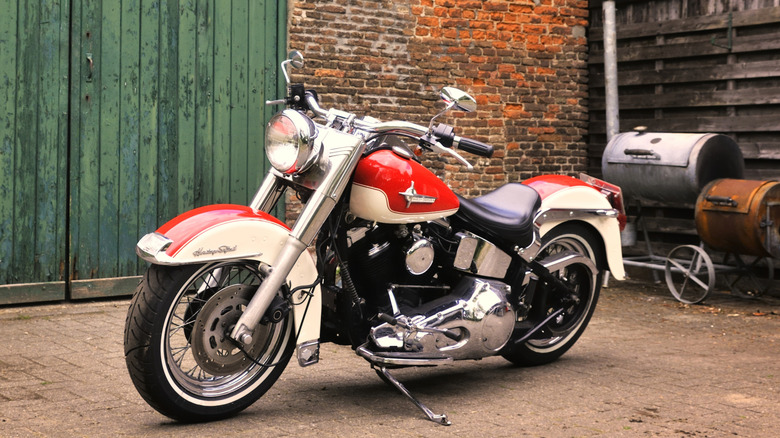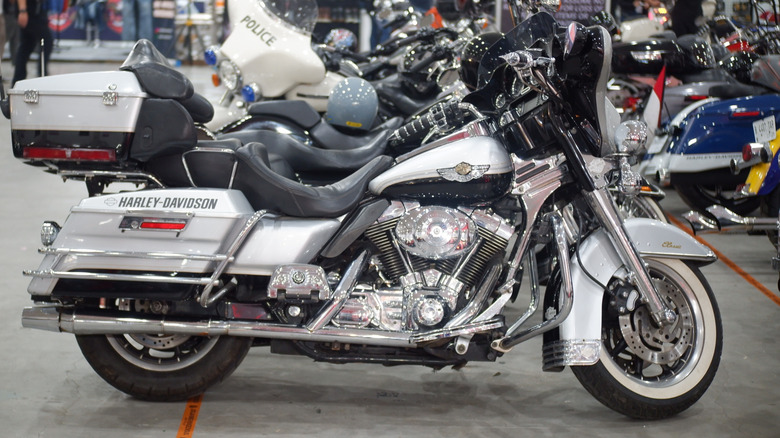Harley-Davidson Softails: The Reason Behind The Frame Name, Explained
For over 120 years, Harley-Davidson has remained a popular motorcycle brand. The company's continued iconic status has been supported by an active and vibrant community, helping retain its appeal of rebellion, freedom, and American heritage. From the very first Harley-Davidson motorcycle, Serial No. 1, the company now has 24 different models available on its website, spread across five main motorcycle categories: Grand American Touring, Trike, Cruiser, Adventure Touring, and Sport. Among the most popular in the Harley-Davidson stable is the softail range, which means it has a suspension system in the back (a hardtail has none).
The origins of the Harley Softail trace to the early 1970's when an engineer and Harley enthusiast named Bill Davis modified the frame of his 1972 FX Super Glide. His first version involved creating a frame that moved the shock absorbers underneath the seat and attached it to a triangle-shaped swingarm. Davis showed his concept to Harley's then-chief design officer, Willie G. Davidson, but no deal was made. Undeterred, Davis refined his prototype and created his own company, Road Worx, to sell his sub-shock frame. By 1982, his partners at Road Worx had left, and again he approached Harley. This time the company accepted and bought all the patents and machinery, effectively selling the Softail technology to the motorcycle brand.
The suspension system of a Softail Harley-Davidson is different from hardtails because of the concealed rear suspension. Located under the seat, it has a monoshock layout, with a swing arm connected to the motorcycle frame. This design gives nearly 4.5 inches of travel for the rear wheels, while hardtails have zero wheel travel. This ingenious configuration gives the motorcycle a softer and more comfortable ride even on rough road surfaces, making it ideal for longer trips.
Softail for comfort and riding ease
The modern Harley-Davidson Softail includes important features that enhance its ride characteristics, including the ability to adjust preload based on rider weight and compression and rebound dampening. Harley owners can also install aftermarket struts and shock absorbers to further refine the suspension. This relaxed and smoother riding experience, however, comes at a price, as Harley-Davidson Softail models are more expensive because they require more parts and cost more to manufacture.
Alongside the acquisition cost, it is also important to consider that Harley-Davidson Softails are more expensive to maintain, as they require regular upkeep to ensure optimal performance. They have a more complex layout, with separate suspension systems for both the front and back, compared to a hardtail, which only has one in the front. Additionally, there are more moving parts in Softails that require repair and replacement, so the long-term maintenance costs will be higher.
Despite having a specialized suspension system, a Softail retains the design language of classic Harley motorcycles. In essence, Harley-Davidson's hardtail and Softail differ in riding experience and handling characteristics. Hardtail motorcycles provide a more genuine and connected-to-the-road feel, but they can be tiring and taxing when used for long rides or tough terrain. Softails, on the other hand, can offer better riding stability and handling while giving a more comfortable ride that is easy on the body, making them perfect for longer journeys or everyday commuting. The Softail has been a popular bike since its release and includes some of Harley-Davidson's most successful models even today, as its combination of comfort and great design is sure to be in demand for years to come.

